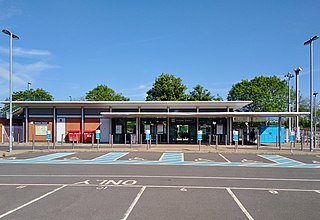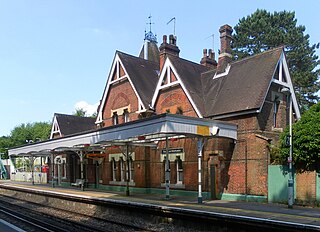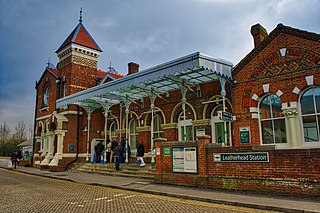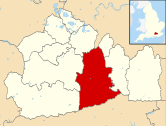
Mitcham Junction is a National Rail station served by Southern and Thameslink trains. It also has a Tramlink stop. It is in the London Borough of Merton and is in Travelcard Zone 4.

Epsom railway station serves the town of Epsom in Surrey, England. It is located off Waterloo Road and is less than two minutes' walk from the town's high street. It is 14 miles 18 chains (22.9 km) down the line from London Waterloo.

Cheam railway station serves Cheam in the London Borough of Sutton. It is located on the Sutton & Mole Valley Lines section from Sutton to Epsom with trains to London Victoria and London Bridge both via Mitcham Junction and West Croydon.

Hackbridge railway station is a railway station at Hackbridge in the London Borough of Sutton in South London. The station is served by Southern and Thameslink. It is in Travelcard Zone 4.

Carshalton railway station is a railway station at Carshalton in the London Borough of Sutton in South London. It is located between Sutton and Hackbridge.

Sutton railway station (sometimes referred to as Sutton (Surrey) on tickets and timetables) is in the London Borough of Sutton in South London and is the main station serving the town of Sutton. It is served by Southern and Thameslink trains, and lies in Travelcard Zone 5, 14 miles 75 chains (14.94 miles, 24.04 km) down the line from London Bridge, measured via Forest Hill.

Raynes Park railway station serves the district of Raynes Park in the London Borough of Merton. It is 8 miles 51 chains (13.9 km) south-west of London Waterloo and is situated between Wimbledon and New Malden on the South West Main Line. The next station along on the Mole Valley branch line is Motspur Park.

Guildford railway station is at one of three main railway junctions on the Portsmouth Direct Line and serves the town of Guildford in Surrey, England. It is 30 miles 27 chains down the line from London Waterloo via Woking.

The Sutton and Mole Valley lines were constructed between 1847 and 1868 by the London, Brighton and South Coast Railway, the London and South Western Railway and the LBSCR-sponsored Horsham, Dorking and Leatherhead Railway.

Horsham railway station serves the town of Horsham in West Sussex, England. It is 37 miles 56 chains (60.7 km) down the line from London Bridge, measured via Redhill, on the Arun Valley Line and the Sutton & Mole Valley Lines, and train services are provided by Southern and Thameslink. Services on the Sutton & Mole Valley Line from London Victoria via Dorking terminate here, as do Thameslink services from Peterborough via London Bridge. The other services continue into the Arun Valley: a half-hourly service from London Victoria to Bognor Regis, and a half-hourly service to Portsmouth Harbour. These trains usually divide here with the front (Portsmouth) portion travelling fast and the rear half providing stopping services.

Hilsea railway station is a railway station on Airport Service Road, Hilsea, Portsmouth, England serving the northern end of Portsea Island, including a large industrial estate nearby. The station was once the closest to Portsmouth Airport, which was closed in 1973.

Ashtead railway station is in Ashtead, Surrey, England. It is 16 miles 19 chains (26.1 km) down the line from London Waterloo.

Box Hill & Westhumble is a railway station in the village of Westhumble in Surrey, England, approximately 2 miles (3.2 km) north of Dorking town centre. Box Hill is located approximately 1⁄2 mile (800 m) to the east. It is 21 miles 14 chains (34.1 km) down the line from London Waterloo. Train services are operated by Southern who manage the station, and South Western Railway.

Leatherhead railway station is in Leatherhead, Surrey, England. It is managed by Southern, with services provided by them and South Western Railway. It is 18 miles 2 chains (29 km) from London Waterloo.

Holmwood railway station serves the villages of Beare Green and South Holmwood in Surrey, England, on the Sutton and Mole Valley Lines between Dorking and Horsham, 27 miles 5 chains (43.6 km) from London Waterloo.

The New Guildford line, presently operated by South Western Railway, is a commuter line between London Waterloo and Guildford. It branches off the South West Main Line at Hampton Court Junction, just south-west of Surbiton. On timetables, trains on this route are advertised as going to Guildford via Cobham.

The Portsmouth line is a secondary main line originally built by the London, Brighton and South Coast Railway and the London and South Western Railway between 1847 and 1868. It leaves the South London Line at Peckham Rye, with connections to the Victoria branch of the Brighton Main Line at Streatham, and continues via Sutton, Epsom and Dorking to join the Mid-Sussex Line at Horsham.
The Epsom and Leatherhead Railway (E&LR) was a railway company in Surrey, England. Promoted independently, it opened its short line in 1859 and was worked by the London and South Western Railway (LSWR). It was transferred to the joint ownership of the LSWR and the London, Brighton and South Coast Railway (LBSCR) in 1860. Those companies operated passenger trains to Waterloo and London Bridge station respectively. In 1867 the LBSCR built an extension line from Leatherhead to Dorking, with the declared intention of continuing to the Sussex coast. A new Leatherhead station was built on the new line, and the LSWR was obliged to build its own independent, new Leatherhead station; this was a terminus for some years.
The Horsham, Dorking and Leatherhead Railway (HD&LR) was an early railway company in southern England. It planned to fill in a gap in the network of the London, Brighton and South Coast Railway, shortening the route from London to coastal towns from Littlehampton to Portsmouth. It only obtained Parliamentary authorisation to build from Horsham to Dorking, and it sold its company to the LBSCR, which completed the construction, and itself built the remaining section from Dorking to Leatherhead.
The Mid-Sussex railways were a group of English railway companies that together formed what became the Mid-Sussex line, from Three Bridges through Horsham to Littlehampton, in southern England. After 1938 the Southern Railway operated a regular electric train service ran from London to Bognor Regis and Portsmouth using the marketing brand "Mid-Sussex Line", leading to an informal consensus. The Mid-Sussex Railway company ran from Horsham to Petworth, and the Mid-Sussex Junction line of the London, Brighton and South Coast Railway (LBSCR) extended from the Petworth line to Littlehampton. The Three Bridges to Horsham branch of the LBSCR was at first the sole access from the north to the Mid-Sussex railways, although a line from Leatherhead was used later.



















